Malaysia attracted over 170,000 visitors from the Gulf countries in 2013, and has been rated the world’s top Muslim-friendly holiday destination in a survey released last year.
According to figures, Malaysia received 102,365 tourists from Saudi Arabia in 2012. The total number of tourists from the UAE was 18,233 during this period.
During the first half of 2013 (January to June), Malaysia received over 53,000 visitors from the Kingdom. In addition, the country also received more than 14,500 visitors from Oman, 9,390 from Kuwait and 7,804 from UAE during the same period.
This Asian country with a 60 percent Muslim population mostly attracts Muslim tourists worldwide and has been a frontrunner with regards to anything halal. The country can be divided into two: Peninsular Malaysia with its amazing cities, forested highlands and fringing islands, and east Malaysia, north of the island of Borneo with its dense rain forests, orangutans and animist tribes. Geographically, Malaysia is almost as diverse as its culture. 11 states and 2 federal territories (Kuala Lumpur and Putrajaya) form Peninsular Malaysia which is separated by the South China Sea from East Malaysia which includes the 2 states (Sabah and Sarawak on the island of Borneo) and a third federal territory, the island of Labuan.
Malaysia’s policy for the tourism sector is to ensure a comfortable environment to all Muslims family tourists in line with its Islamic lifestyle. Moreover, the Malaysian government bans any activities that violate Islamic laws to let Arab tourists feel that they are in a Muslim country. At the same time, the government is careful to prove the country has a halal tourism sector targeting a large number of tourists from Arab Gulf countries.
The road to Kuala Lumpur (KL):
Kuala Lumpur is the biggest city of Malaysia and one of the top ten most visited cities. It is not surprising to find a wide range of hotels there to suit all budgets, ranging from international luxury class hotels, medium range hotels and the hotels for the truly budget conscience traveler. This is apart from the numerous youth hostels that are tucked away behind the backstreets of Bukit Bintang shopping district.
In addition, there is also the homestay program where visitors can really experience what genuine Malaysian hospitality is all about, amid the tranquil countryside, by staying in a Malay village.
For the convenience of weary travelers, there are two international class hotels in Kuala Lumpur International Airport (KLIA). They are the Concorde Inn KLIA and the Pan Pacific KLIA. Both are within 5 minutes of walking distance from the arrival hall. The Concorde Inn KLIA is a 5-Star 338-room hotel with four types of rooms. There are “Superior” rooms, “Deluxe” rooms, “Executive” and “Suites.
The Pan Pacific Kuala Lumpur International Airport is another 5-Star hotel located near the main terminal of KLIA. The Pan Pacific KLIA makes a great place to unwind after a long and tiring journey. The facilities here are top class and in fact the Pan Pacific KLIA is also the first hotel in Asia to ever use a Digital Food and Beverage Menu.
When you journey to Kuala Lumpur from KLIA, you will enjoy the green areas and farms on either side of the road. Kuala Lumpur has a tropical rainforest climate which is warm and sunny, along with abundant rainfall, while temperatures tend to remain constant around the year.
Bukit Bintang:
A lot of tourists especially from Arab countries prefer to stay in Hotel Istana which is located near Bukit Bintang also known as “Arab Street.” Rooms at Hotel Istana are fully air conditioned and feature large windows overlooking the scenic cityscape of Kuala Lumpur. Each room is equipped with a cable satellite TV, tea and coffee making facilities and free wired Internet.
In addition, the well-equipped fitness center features a personal trainer, as well as yoga and salsa classes. Guests may also relax with massage treatments and a spa bath at Sompoton Spa. Urban Restaurant also offers an Asian and International menu, while Taman Sari Brasserie serves Malaysian buffet-style dishes. Drinks may be enjoyed at The Sports Bar or Songket Lounge. Fresh cakes and bread are also available at The Deli.
The location of Hotel Istana helps Arab tourists to visit Arab Street which includes a lot of Arab restaurants and cafes. The street is also a commercial center including many stores for shopping. Arab Street is packed with tourists from July to September when many tourists from Arabia come to Malaysia for vacation. Many Arabs flee their countries during that period to avoid the burning temperatures in the Middle East. Ain Arabia is also a haven for Middle Eastern food lovers.
There are a number of restaurants which serve Arabian cuisine such as the Sahara Tent Restaurant which is located at Hotel Fortuna Kuala Lumpur. The attractions at Ain Arabia were initially intended for the foreign tourists but now this place is frequently visited by many locals as well.
If you would like to bite into some really good authentic Arabian food and experience the Middle Eastern lifestyle without having to travel to the Middle East, come on over to Ain Arabia. There are other attractions around Ain Arabia since it is so close to Bukit Bintang.
This street is also near the Pavilion Kuala Lumpur which is a shopping mall. It was built on the former site of Bukit Bintang Girls School, the oldest school in Kuala Lumpur. It was opened on Sept. 20, 2007 and consists of four major components: a retail mall, an office tower, two residential and a proposed hotel.
There are several fashion and luxury goods boutiques that encompass a large portion of the mall’s retail floor area. Several eateries and cafés also exist in the shopping mall like fast food restaurants and coffee chains. Anchor stores include Parkson and the Singaporean departmental store.
Best malls in KL:
Kuala Lumpur has the best shopping experiences where bargains can be found. There are 5 top favorites for the best malls in the city. Suria KLCC which is an extravagant mall is located directly underneath the Petronas Twin Towers building, which was formerly the world’s tallest building.
It’s a 6-story mall, which includes many of the top designer brands from both Asia and Europe. During the year, prices are quite high, but during the annual Malaysia Mega Sale Carnival held in August, you will see prices slashed up to 80 percent. Bargains here during sale times are some of the best in Kuala Lumpur, especially because you’re getting high-end items for a great price.
Also, there is Bukit Bintang and Sungei Wang Plaza which are technically two malls right next to each other and connected in various places throughout the two buildings. They are right next to the hotel I stay at, so I spend a lot of time here. They are also right next to the monorail that originates at the main train station, so are easy to get to.
Berjaya Times Square. Billed as one of Asia’s largest shopping malls, Berjaya Times Square is truly huge. Its many floors seem to stretch up to the skies, and the view from the ground floor up is breathtaking. This is also the shopping mall where contestants from the Amazing Race Asia rappel down to the ground floor from the eighth floor: scary stuff.
One Utama is a bit out of the way, as it’s in a residential area of KL outside the city. I took the train to the Kelana Jaya LRT stop and then got off and took a taxi, which got me there in an additional 7 minutes or so. One Utama has 6 floors and around 600 shops. It’s known for its tropical indoor rainforest with many species of tropical plants and flowers. Here you can get something to eat or drink at one of the delightful cafes and restaurants in the rainforest. It also has a great kid’s entertainment section and a bowling alley, rock climbing arena and movie theater.
Mid-Valley Mega Mall is the most popular mall in the city, which you can easily get to by taking a bus from KLCC right to its doorstep. It is anchored by several large department stores or megamarts including Jusco, Carrefour and Metrojaya. It also has a few hundred other stores, two hotels, a large bookstore and several enormous food courts. Add a bowling alley, Kuala Lumpur’s largest cinema complex, an amusement arcade and over 100 places to eat, and you could spend all day and night here.
Entertainments:
Safari Lagoon Rooftop Water Theme Park is one of the most unique tourist attractions in the country. Safari Lagoon Rooftop Water Theme Park is located on the 7th floor of Pandan Safari Lagoon Shopping Complex. It covers about 2 acres and is able to hold around 3,000 people. Once inside, never-ending fun follows. You can leave your child inside the theme park while you continue your shopping. The place is adorned with lots of animal sculptures and verdant sceneries to maintain the safari look of the theme park.
Desa WaterPark is a genuine family entertainment water park filled with exciting and thrilling facilities. It boasts of having the longest Master Blaster in all of Asia called the “Thunderbolt.” With plenty of regular water slides and three wave pools, it is understandable why the locals love this place so much. Desa WaterPark occupies about 5 hectares of space to provide fun under the sun with its 12 water rides. A perfect place to spend special occasions, the water park is complete with food stalls, lockers, restrooms, an amphitheater and a souvenir shop.
Istana Budaya is considered to be one of the most sophisticated theaters, and is consistently voted as one of the world’s top 10 theaters. It primarily serves as a venue for the performing arts with a seating capacity of 1,469.
One of the unique attributes of Istana Budaya is that it has four adjustable stages which can be moved depending upon the requirements of the show. Aside from the regularly featured performances, the building itself is a wonderful attraction which displays intricate Malay architecture. Istana Budaya is one of the country’s most prominent landmarks and you will surely enjoy your time adoring its structure or spending the night with a date watching a featured performance.
Email: Life.style@arabnews.com
Malaysia’s halal tourism attracts Muslims from all over the world
Malaysia’s halal tourism attracts Muslims from all over the world

Saudi traditional crafts on show at Jouf camel auction

- Women demonstrate art of making sameel storage pouches
RIYADH: The art of making leather containers for storing food and drinks was just one of the attractions at the recent Jouf camel auction in Dumat Al-Jandal governorate.
With 2025 designated as the Year of Handicrafts, festivals across Saudi Arabia are providing important platforms for artisans to showcase and market their traditional skills.
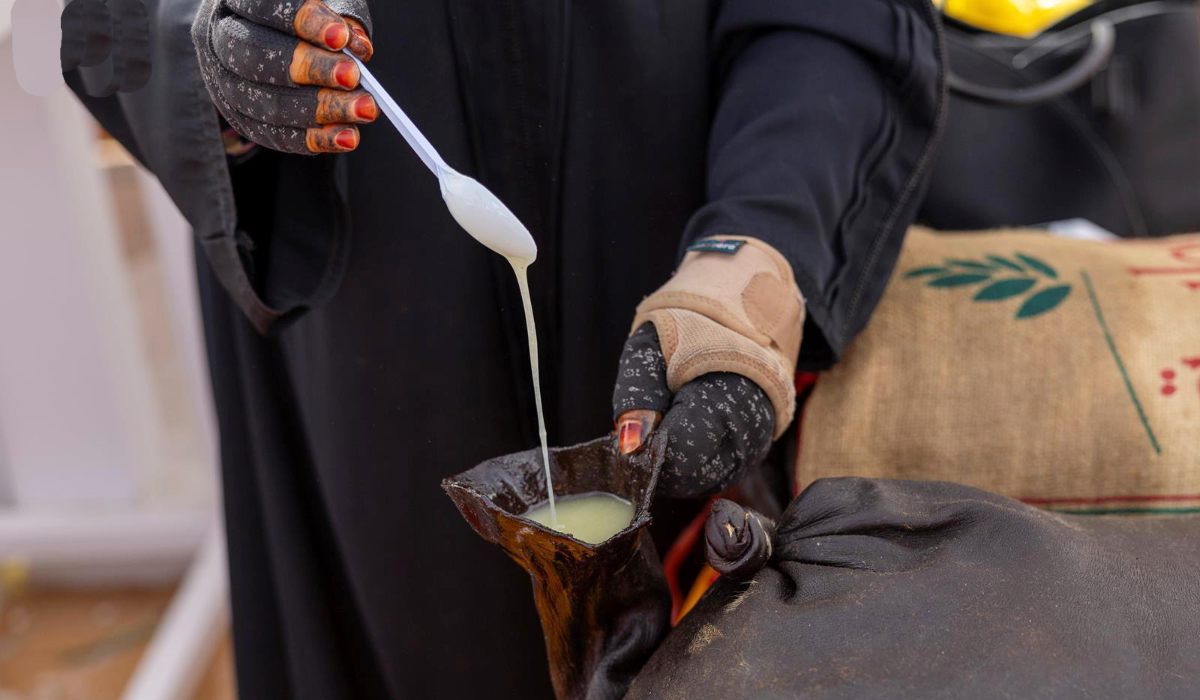
At the camel auction, which ends on Tuesday, craftswoman Umm Meshaal, told the Saudi Press Agency how she produced sameel, a type of pouch made from animal hide and used for storing ghee, yogurt and water.
Meshaal said that sheep skin worked best for keeping yogurt, while goat skin was better for ghee.
FASTFACTS
• At the Jouf camel auction, craftswoman Umm Meshaal told the Saudi Press Agency how she produced sameel.
• It is a traditional pouch made from animal hide and used for storing ghee, yogurt and water.
The process starts by tanning the skins using a tree extract and salt to remove the hair and any impurities. The hides are then left to dry before being cut and sewn together into the desired shape.
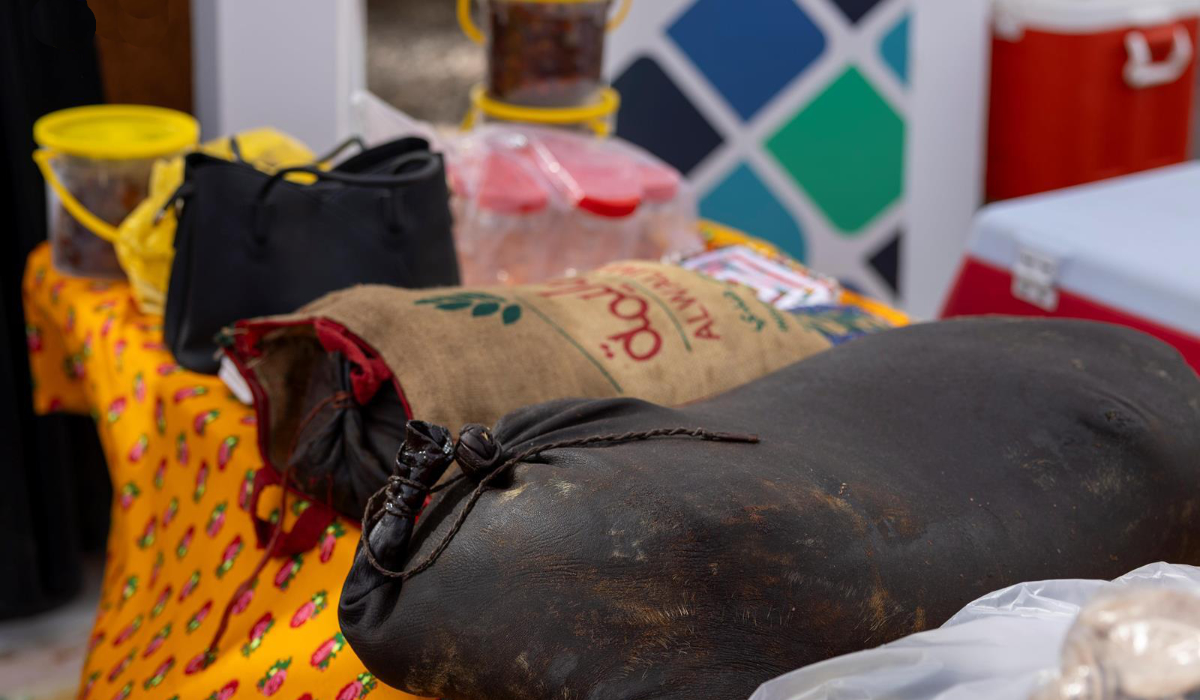
The ancient art of making sameel is still relevant in modern-day Jouf, particularly among Bedouin communities who use them for storing and carrying vital supplies.
Many consumers say the best ghee in the Kingdom comes from these traditional vessels, the report said.
A look at NEOM’s prehistoric masterpieces etched in stone

- Open-air museum of ancient artworks is key to decoding past civilizations
- Drawings reveal how human beings interacted with now-extinct animals in the area
MAKKAH: In the heart of NEOM’s Hisma Desert, where sandstone mountains and plateaus rise from the arid landscape, is an extraordinary collection of ancient rock art and archaeological inscriptions. These priceless treasures illuminate the cultural and economic vitality of long-lost civilizations.
Once a vital corridor for caravans travelling the ancient trade routes of the Arabian Peninsula, this region preserves an invaluable legacy etched into its geological formations.
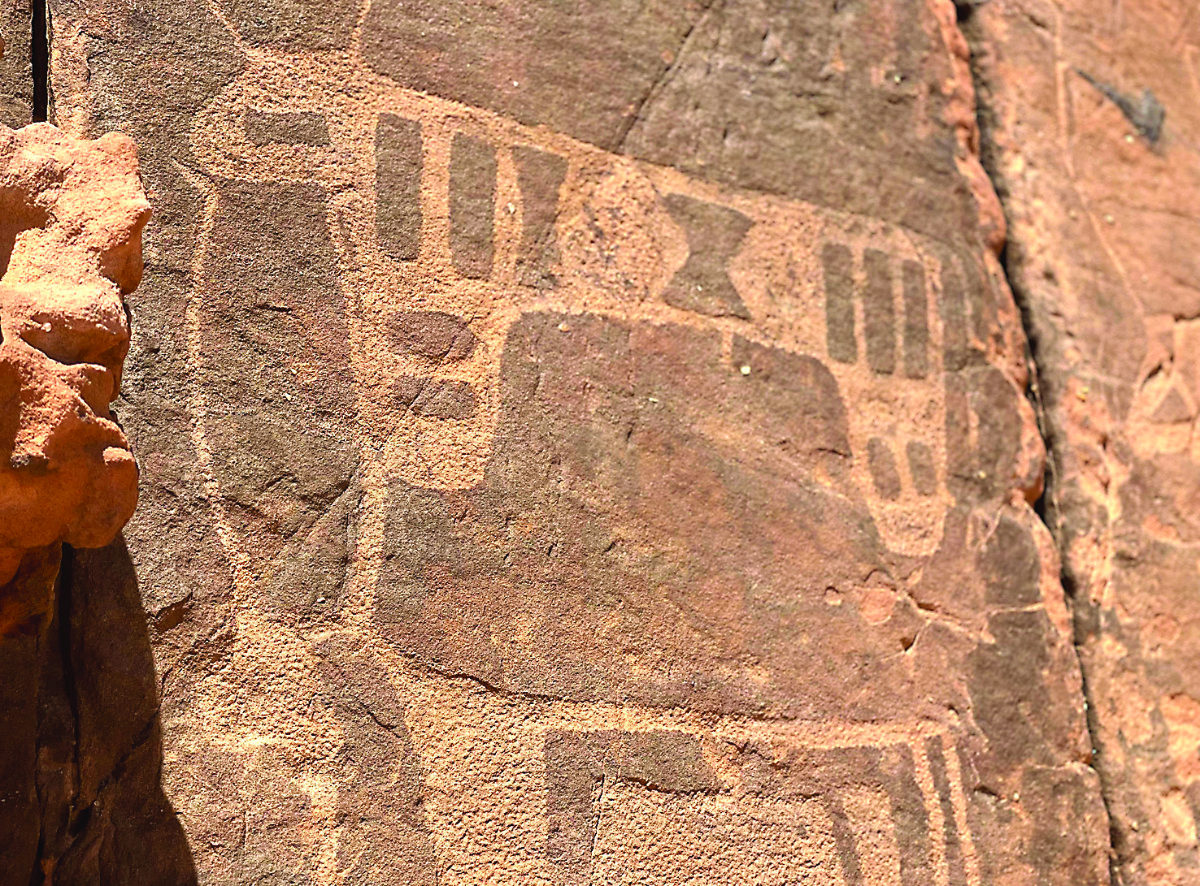
Abdulelah Al-Fares, a photographer and expert in ancient artifacts and a member of the Saudi Heritage Preservation Society, told Arab News that the rock art is in the mountains and plateaus in NEOM, part of a mountain range in the northwestern part of Tabuk.
Hisma Desert is bordered by the Sharah Mountains to the north, by Wadi Araba to the northwest, by the Hijaz Mountains to the west, and by Harrat Al-Raha to the south.
HIGHLIGHTS
• Studying rock art in the region matters deeply because it reveals economic and cultural changes that shaped the northern Arabian Peninsula.
• The drawings show how people interacted with now-extinct animals in the area, as well as with livestock and camels.
• Among the standout examples are life-sized camels crafted with remarkable precision and aesthetic detail.
“The plateaus, part of the Hisma Desert and its geological formations, represent an open-air museum of nature, ancient rock art, and diverse historical inscriptions,” he said.
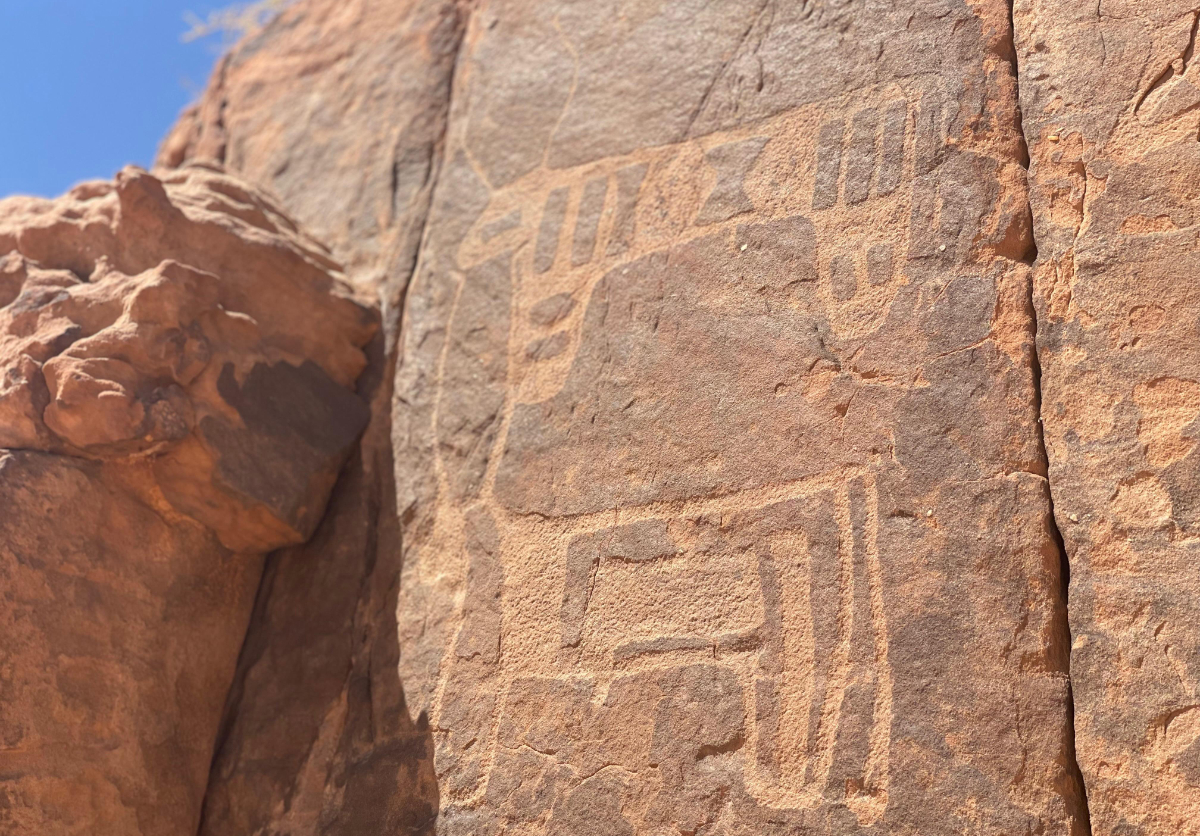
The rock drawings feature engravings of human figures, animals and various scattered scenes throughout the site.
The engravings on the plateau’s facades depict scenes of animals, including wild animals such as camels, cattle, ibexes, ostriches and wolves, as well as other predatory animals, and depictions of hunting scenes and human combat.
These drawings are notable for their precision and have remarkably withstood the elements for thousands of years.
Abdulelah Al-Fares, Saudi Heritage Preservation Society member
“These drawings are notable for their precision and have remarkably withstood the elements for thousands of years,” he said. “Most of the themes and scenes in some of the rock drawings in the region are repeated and depict, to some extent, the world of wild animals and the interactions of humans through hunting and warfare.
“The mountains embody a civilizational and cultural legacy through their distinctive rock drawings featuring human and animal forms,” Al-Fares said.

He also highlighted the value of exploring NEOM’s ancient rock art. These carvings — depicting animals, hunting scenes and human figures — are a bridge between our modern lives and the world of humans thousands of years ago. They are a source of cultural and historical knowledge.
The artworks also illuminate the journey of human civilization, revealing its cultural and social evolution in the region.
Scattered throughout the area, a wide array of rock art sites show a vast and dense collection of drawings and archaeological inscriptions from different eras etched on mountain surfaces.
Al-Fares pointed out their diversity, noting the varied artistic styles, forms, and themes that distinguish each piece.
Among the standout examples are life-sized camels crafted with remarkable precision and aesthetic detail. The careful attention to detail is thought to underscore the camel’s role as an essential sources of food and transport in ancient times.
Another façade shows a herd of cows, all facing forward, their large crescent-shaped horns curving at the tips. Encircling this herd, human figures of varying sizes are skilfully carved.
These ancient artworks are pictorial panels of human history, activity, environmental adaptation, and cultural development during ancient times. Their value shines brighter given the scarcity of insights into prehistoric life.
Studying rock art in the region matters deeply because it reveals economic and cultural changes that shaped the northern Arabian Peninsula.
The drawings show how people interacted with now-extinct animals in the area, as well as with livestock and camels.
Many carvings portray human beings astride animals, including a warrior wielding a spear and sword, rendered with finesse and skill.
Scattered throughout the region, some drawings hint at the presence of different ethnic groups that lived in the area. The provide clues to migratiosn and trace the routes of trade caravans that used these locations as settlement points.
Saudi Arabia’s Hail poppy reserve attracts thousands of tourists

- Since opening in 2022, the reserve, which covers 10,000 sq. meters, has drawn thousands of domestic and foreign visitors
HAIL: With its vibrant array of wildflowers framed by golden sand dunes and majestic mountains, the Poppy Reserve in Al-Khattah is one of the Hail region’s most captivating attractions.
Since opening in 2022, the reserve, which covers 10,000 sq. meters, has drawn thousands of domestic and foreign visitors, particularly during holidays, Eid and the spring season.
The attraction enchants guests with its sweeping fields of poppies, perfectly balanced in form and color. As the sun sets, the golden rays cast a warm glow over the landscape and create a natural wonder.
This striking beauty enhances the region’s reputation for breathtaking scenery and offers a unique experience.
Madinah Retreats: Culture, spirituality to power up the soul

- Paradigm shift blends wellness practices, cultural expeditions, spiritual experiences
JEDDAH: In the sacred embrace of Madinah, one of Islam’s holiest sites, a new culture-oriented wellness experience is offering a journey that integrates spirituality, culture, and heritage.
The inspiration behind Madinah Retreats stems from founder Moatassem Al-Bitar’s experience in the wellness and spiritual tourism industry in Saudi Arabia and beyond.
Recognizing key gaps in traditional retreat models and leveraging Saudi Arabia’s tourism vision, he envisioned a paradigm shift that blends modern wellness practices, cultural expeditions, and spiritual experiences into a single journey.
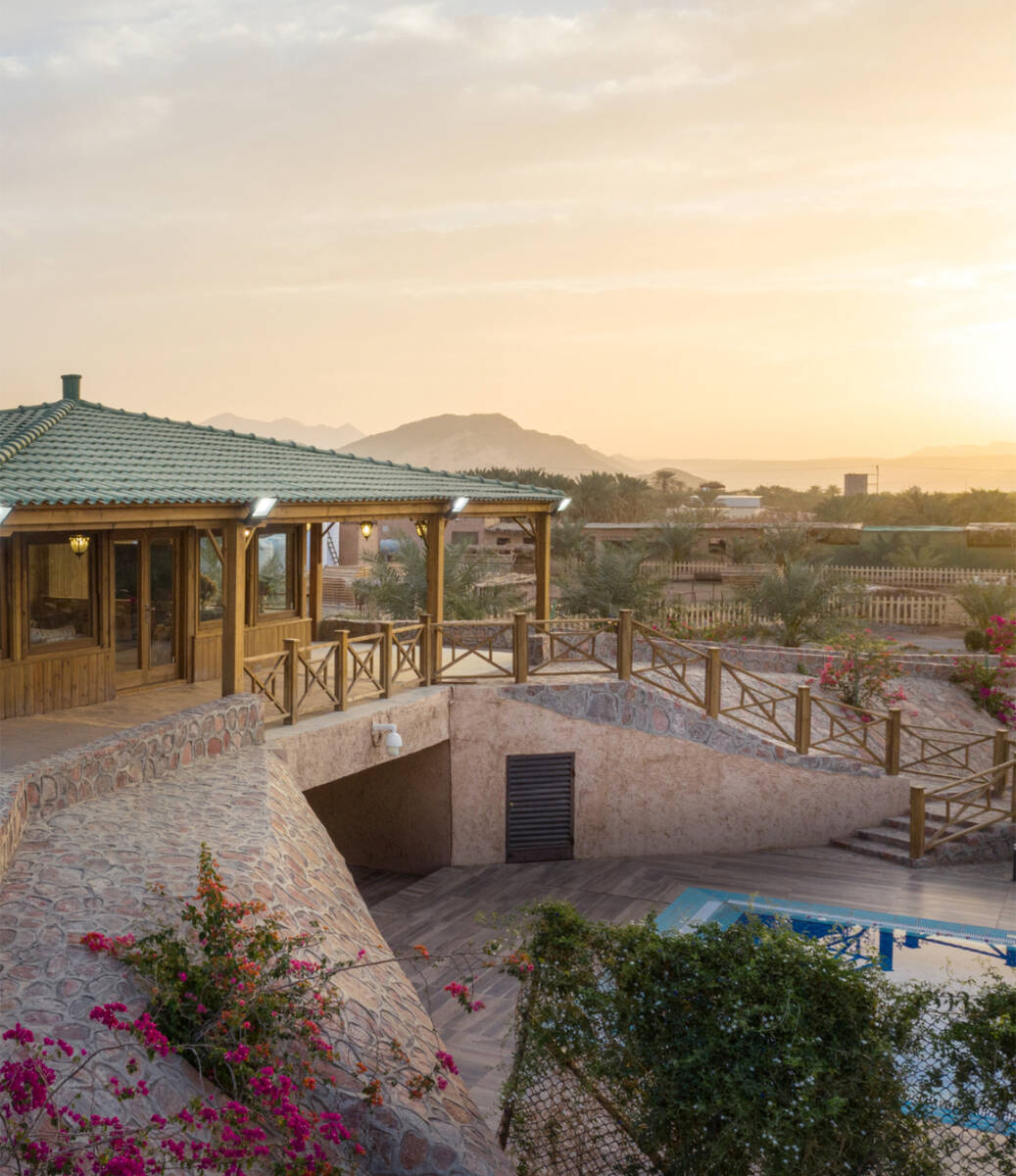
With a background as a corporate culture change and people engagement manager, Al-Bitar has curated over 50 retreats across Saudi Arabia, Egypt, and the US, serving more than 400 participants.
His academic training spans diverse fields, including organizational behavior, Islamic spirituality, and intercultural studies.
Officially launched in 2024 after five years in the making, the initiative held its second retreat, under the theme “The Arrival,” earlier this year in Madinah.
FASTFACTS
• Madinah Retreats stems from founder Moatassem Al-Bitar’s experience in the wellness and spiritual tourism industry in Saudi Arabia and beyond.
• It blends modern wellness practices, cultural expeditions, and spiritual experiences into a single journey.
Al-Bitar told Arab News: “Every retreat we design starts with clear intentions and objectives, supplemented by a story and a theme that aligns with a particular destination.”
The retreats feature a collective of facilitators who work together toward a unified intention, ensuring a balanced and immersive experience.
“One of our main goals is to promote different destinations in Saudi Arabia that are perfectly ideal for wellness-centric experiences, in addition to its unmatched culturally enriching character,” Al-Bitar said.
“We seek to partner with pertinent governmental initiatives and entities that fulfill the Kingdom’s Vision 2030 for wellness tourism and exceptional experiences.”
Al-Bitar explained that each retreat is meticulously structured around three core pillars: spirituality (meditative practices and inner reflection); culture (heritage site visits, traditional storytelling, and local experiences); and wellness (movement–based practices, mindfulness exercises, and healing foods).
By integrating these elements into daily programs, Madinah Retreats offers a journey tailored to the needs of participants and is a “philosophy of being rooted, real, and rich.”
The retreats target individuals and groups seeking genuine transformation in their well-being, spiritual connection, and cultural enrichment. They provide a safe and accepting space where participants are respected on their unique paths to healing.
Madinah, which is the spiritual capital of Islam, is popularly known as the Illuminated City. It offers an atmosphere of peace and rejuvenation, and its diverse topography and climate make it ideal for nature-based healing.
“Madinah is widely recognized as a destination where the heart feels at peace, the body feels rejuvenated, the mind feels clarity and the soul feels enriched,” said Al-Bitar. “The city’s rapid development and recognition as a top global tourism destination further enhance its appeal.”
The Madinah Retreats experience is usually hosted in a traditional farm resort surrounded by nature. Participants visit cultural and historic sites, explore the city’s vibrant social scene, and experience local cuisine, contemporary art, and community traditions.
“During the retreat we offer meditation, breathwork, self-reflection, yoga, tai chi, and other somatic therapies, creative expression as a healing tool, as well as locally sourced, nourishing meals,” Al-Bitar added.
The somatic practices guided by expert facilitators enhance body awareness and overall well-being.
Al-Bitar said: “Connecting with nature and animals has proven therapeutic benefits. Madinah Retreats incorporates nature-based and equine therapy to help participants reconnect with their original disposition, providing an irreplaceable form of healing.”
Cultural storytelling is also an essential component, allowing participants to explore the hidden wisdom of each landmark and understand local traditions and historic practices.
No prior experience in meditation or wellness practices is required, making the retreats accessible to all.
Honoring his Egyptian roots, Al-Bitar is expanding the retreats to Siwa, Egypt.
Siwa Oasis, nestled within a breathtaking desert landscape, is characterized by vast dunes, striking limestone outcrops, and distinctive geomorphological features that enhance its appeal as a tourist destination.
“The expansion to Siwa, Egypt, was inspired by the oasis’ 160-year-old tradition of reconciliation — Eid El-Solh, a celebration of harmony,” Al-Bitar said.
“Siwa’s natural healing elements, such as salt lakes, hot springs, and lush landscapes, mirror many of Madinah’s restorative qualities.”
Al-Bitar said that Madinah Retreats will also explore the Kingdom’s hidden gems by hosting retreats in Abha, Aseer, Al-Ahsa, and other locations rich in healing nature and cultural heritage.
Retreat prices range from SR5,000 ($1,333) to SR10,000, depending on the location, program, facilitators, transportation, and accommodation.
Madinah Retreats follows a collaborative model, partnering with local service providers, facilitators, and experts to provide an experience that remains true to the cultural essence of each destination.
Al-Bitar said: “Our content caters to people from different backgrounds, both English and Arabic speakers. Our agenda is characterized by being spacious and offers ample time for self-guided practices. Our way of delivery is strictly non-intrusive.”
Participants leave Madinah Retreats feeling “transformed, enriched, and connected to their most authentic selves.”
Al-Bitar said that the experience embodied the profound wisdom: “You presume you are a small entity, but within you is enfolded the entire universe.”
Madinah Retreats also provides a customized retreat model that caters to corporations and teams, as well as add-on visits such as expeditions in AlUla.
High-end design with luxury service: The Jeddah Edition

JEDDAH: With its sleek, contemporary design that combines modern luxury with understated elegance, it’s no surprise that the Jeddah Edition won Best Hotel Design at last month’s Saudi Commercial Interior Design Awards.
The high-ceilinged lobby is gorgeous — its orange acrylic sphere, created by Vincent Leroy, really pops against the sunset and created such a perfect vibe as I walked in.

The welcome was as impressive as the surroundings, with Saudi coffee and dates served before I’d even checked in. The check-in process was smooth and efficient, setting the tone for a relaxed and enjoyable stay, throughout which the staff were always friendly and quick to respond to any requests, ensuring visitors feel well taken care of.
My spacious deluxe room, thoughtfully laid out, instantly made me feel at home. The beige-and-white color scheme, balanced by the perfect lighting, created a calm and comfortable environment, while the bathroom’s freestanding tub and signature Le Labo toiletries added a touch of luxury.
In the evening, I headed down to the Lobby Bar to grab a light snack. The atmosphere was lively — there’s a snooker table and a selection of games for guests to enjoy — but cozy too, with blankets and shawls draped over the comfortable sofas. I sampled some of the delicious snacks, including vegetable spring rolls and zucchini chips paired with a brinjal sauce dip, before heading out for a stroll around the nearby art promenade.

While there are many excellent dining options within the hotel, its location near the Jeddah Yacht Club and Marina provides easy access to a variety of great spots, ideal for foodies.
As night fell, I made my way to the poolside lounge on the Edition’s roof terrace. This quickly became one of my favorite spots, with its panoramic views of the marina and the Formula 1 racetrack.
In the morning, I indulged myself with a relaxing massage at the hotel’s Aromatic Spa, an experience which began with a refreshing cup of lemon mint tea with a few drops of chamomile. The spa facilities were immaculate, with separate changing rooms and bathrooms. For couples, there’s a special treatment room that includes a private balcony.
The food at the hotel was excellent. At the Maritime restaurant, which serves a contemporary French-Asian menu, there are breakfast and lunch buffets, while for dinner, the à la carte menu offers a selection of dishes designed for sharing. I was particularly impressed by the monkey bread, shrimp dumplings with lemongrass beurre blanc and caviar, lamb shank, and perfectly cooked beef short ribs. The restaurant’s terrace, framed by pink bougainvillea and 150-year-old olive trees, and with views of the Red Sea, provided an exceptional setting for dining.
After eating, I headed to The Den, a cozy lounge perfect for those looking to unwind with a cigar or enjoy a light drink. With tufted teal velvet banquettes and a classic ambiance, The Den is an intimate setting that contrasts beautifully with the lively energy of the rest of the hotel.
There were several other amenities I made use of, including a well-equipped gym and the rooftop pool. Sadly, the latter, while an excellent spot to relax under the warm Jeddah sun, isn’t really large enough for anyone wanting to get some proper swimming in.
That was a minor gripe, however, and overall my stay at The Edition was an experience I would be happy to repeat. If you’re looking for a relaxing, luxurious stay in Jeddah, it’s hard to beat.
























